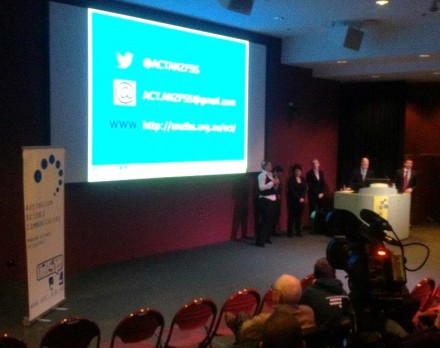My Bio-festo (part bio, part manifesto)
By Rod Lamberts
The first time I heard the term ‘science communication’ was 16 years ago. I was reading an article about water quality in the Canberra Times and I remember thinking, I’m really not interested in water quality, but that was still a damn good read. The by-line said the author was a science communication grad student at some place called the Centre for Public Awareness of Science at the ANU. I thought I knew the ANU pretty well, but I’d never heard of this ‘CPAS’ place. It sounded interesting, so I decided to investigate.
A few phone calls, an interview, some meticulous bureaumancy, a PhD in science communication, 15 years making a nuisance of myself and boom, I’m deputy director of one of the oldest, largest and most diverse academic science communication centres in the world. I now get to teach, learn, research, offer advice, cast opinions, mingle with people I’d never dreamed I would meet, travel the world, and have some of the most inspiring (also sometimes confronting) conversations of my life. And I get to call it all ‘work’. I have to say, it’s not a bad gig.
Before coming to sci-comm, I wandered through the academic worlds of psychology and medical anthropology. Both very interesting and fun, but neither fully worked for me. I also tolerated a suit job for an entire 7 months (meh…), and before that, spent a year and a half in the bush making corporate types talk-and-play-nice with each other.
I’ve been a bouncer, a psych research consultant, pumped petrol, sold army surplus and even used to be a pretty flash grill cook. But the most fun I’ve had, and the most consistently interested I’ve been, has been since I started playing in the science communication space.
But enough on my background, I’m keen to consider here what actually is in the science communication space.
We all know sci-comm is a complex and diverse animal. A science communicator might be a scientist, a journalist, a performer, a researcher, a film-maker, an evaluator, a trainer, a writer, a policy-player, an author, a commentator or a teacher. We might serve in the public, private, or non-government sectors. We could work in a one-person outfit or a large corporation. We are practitioners, theoreticians and everything in between. In short, we are a bloody diverse mob.
So if science communication is so broad, what then does it mean to be ‘a science communicator’? To be honest, I’m not entirely sure. In fact, I’m not sure that trying to define it by what we do is the best way to go. In my 15 years of science communicatistry, the main thing I’ve seen uniting people in this broad church is a flock of attitudes rather than any single, or unique, practice.
We seem to have a positive – but still critical – view of science and its benefits. We have an abiding fascination with new knowledge, a passion to share what we know with others, and a desire to make a positive difference. We want our world to be driven by evidence-based ideas, evidence which includes social and cultural morés as well as facts gleaned in the lab.
In short, I think we are united more by ethos than activity.
What we also share is a professional or personal stake in a world where science communication – however defined or practiced – is a term now in common use. It is increasingly being seen as a fundamental part of human scientific endeavour.
This suggests to me that the time has never been more ripe for us to take stock of what the ASC and its members represent, and how we might evolve.
When I nominated for the presidency, I was especially driven to do so because I believe that it’s time to take the next step as an association: it’s time to professionalise.
A fitting first step for this will be to agree on a code of practice (and/or ethics) which reflects the ethos we share as members of the association. To do this, we will have to have some robust, inclusive discussion about who we are, what we are, and what we embody.
Once agreed, a code of practice plants our banner. It shows the outside world what the ASC and its members stand for, and acts as a yardstick against which we can critique our own actions. It’s going to take a while and is bound to be a little contentious at times, but I think it will be worth the growing pains.
More soon!
Rod
Anyone who has ideas, concerns or questions about professionalising the ASC, please do get in touch with me rod.lamberts@anu.edu.au

